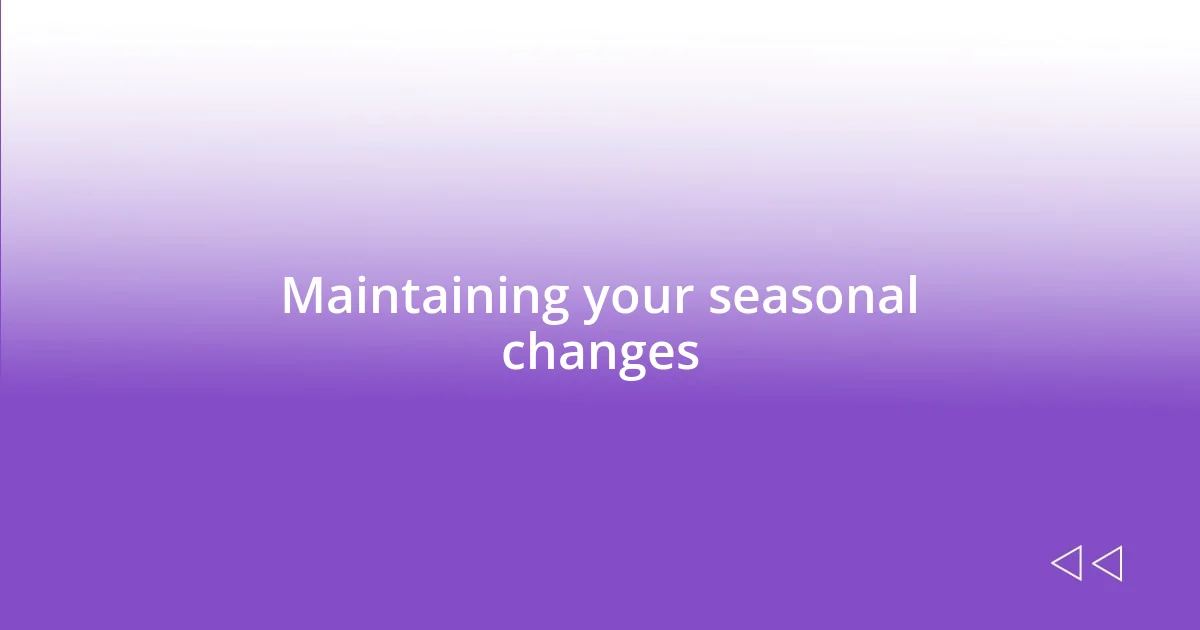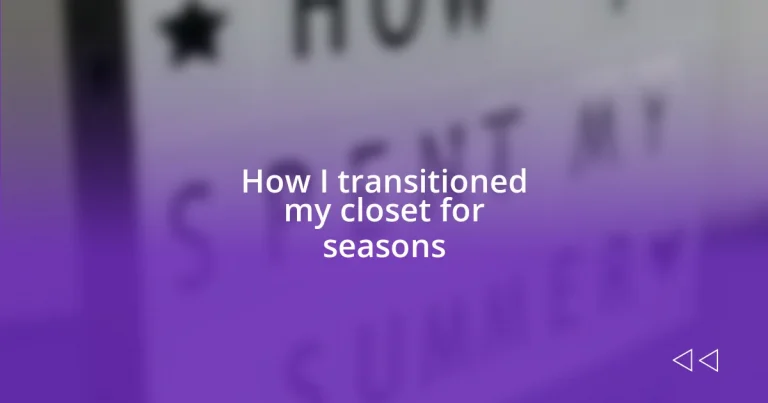Key takeaways:
- Understanding seasonal wardrobe needs improves comfort and confidence by aligning clothing choices with weather and personal style.
- Assessing your current wardrobe involves reflecting on emotional attachments, functionality, and versatility to maintain a practical and joyful closet.
- Creating an organized system and maintaining seasonal changes through regular check-ins and thoughtful additions enhances wardrobe efficiency and personal expression.

Understanding seasonal wardrobe needs
Understanding seasonal wardrobe needs requires a bit of introspection and awareness of how different weather affects our clothing choices. I remember when I first realized my summer shorts just didn’t cut it for chilly autumn days. It’s about knowing what works best for you in each season—what fabrics, colors, and styles make you feel both comfortable and confident.
As the seasons change, so do our lifestyles and activities. For instance, during winter, I find myself reaching for cozy sweaters and functional boots, while in spring, I’m drawn to lighter layers and vibrant florals. Have you ever noticed how your mood shifts with the seasons based on your wardrobe? There’s something uplifting about wearing clothes that reflect the cheerful vibe of blooming flowers and bright sunshine.
Additionally, it’s essential to consider how your wardrobe can enhance your everyday life. I can’t tell you how freeing it feels to have a closet that not only suits the season but also aligns with my personal style and daily activities. Think about your own experiences—does your clothing match your seasonal activities, or do you often find yourself scrambling to put together outfits?

Assessing your current wardrobe
When I look at my closet, I often feel a mix of excitement and overwhelm. It’s important to honestly assess what I truly wear and what just hangs there collecting dust. For instance, I remember a time I held onto a gorgeous dress that I adored but never wore because it just didn’t fit my active lifestyle anymore. Have you ever felt that tug of nostalgia for something that no longer fits your life?
Another aspect that stands out during this assessment is evaluating the condition of each item. I often find that separating items into ‘keep,’ ‘donate,’ or ‘repair’ piles becomes an emotional journey. I’ve had a few beloved pieces that I clung to, feeling a bit sad to part with them, but discovering they didn’t serve a purpose in my collage of seasonal attire. This year, I’ve embraced a pragmatic approach: if it’s not functional or doesn’t spark joy when I wear it, it has to go.
Lastly, understanding how items mix and match can elevate your wardrobe significantly. I’ve learned that a few multifunctional pieces can really streamline choices. I like to think about outfits that transition smoothly between seasons, like my lightweight cardigan that layers perfectly over summer dresses and works just as well with a winter ensemble. Do you have similar pieces that offer versatility? They can become your wardrobe staples.
| Assessment Criteria | Reflective Questions |
|---|---|
| Frequency of Use | Which items do I wear regularly? Are there any that I rarely touch? |
| Emotional Attachment | How do I feel about each piece? Are there items I hold onto for sentimental reasons? |
| Condition | Are my clothes in good condition? Do any need repairs or replacements? |
| Versatility | Can I mix and match items easily? Are there multifunctional pieces that serve multiple seasons? |

Creating a transition checklist
Creating a transition checklist can streamline the often daunting task of seasonal wardrobe swapping. I’ve found that having a written checklist keeps me focused and accountable, preventing any last-minute scrambles. For example, I remember a time when I neglected to put away my summer sandals, only to wear wet shoes on a rainy autumn day. It’s about creating a plan that suits your lifestyle and preferences.
Here’s a handy checklist to consider:
- Identify key seasonal pieces: List must-haves for the upcoming season.
- Check for wear and tear: Inspect items for damage and decide on repairs.
- Sort through the closet: Set aside items to donate or discard.
- Mix and match: Plan outfits ahead to maximize versatility.
- Store off-season pieces: Use bins or vacuum-sealed bags to save space.
- Reflect on emotional impact: Consider which pieces bring you joy and confidence.
This checklist not only makes the process smoother but also helps me cultivate a wardrobe that feels both functional and joyful, keeping my closet as a space of inspiration rather than chaos. When I can see everything clearly, the transition becomes a celebration of fresh beginnings rather than a chore.

Adapting to seasonal colors
Adapting to seasonal colors involves more than just swapping out clothing. When I dive into my closet transformation, I pay special attention to the mood that each color evokes. For instance, I recall a beautiful deep burgundy sweater that always lifted my spirits in the crisp autumn air. It’s amazing how certain hues can resonate with the season’s energy—what colors make you feel alive in the colder months?
I also see adapting to seasonal colors as an opportunity for self-expression. Recently, I shifted to softer pastels for spring, and it felt refreshing. It’s surprising how wearing lighter shades can influence my mindset, making me feel more open and ready for change. Have you noticed how your wardrobe colors can affect your emotions or reflect your state of mind? I encourage you to experiment with shades that evoke the feelings you want to nurture at different times of the year.
Lastly, I like to think about how these colors interact with my wardrobe staples. Incorporating seasonal colors means I often bring in a few key accessories, like a new scarf or handbag. It’s a low-commitment way to refresh my looks without an entire wardrobe overhaul. I’ve found that even changing the color palette can make me excited about old outfits again. What’s your experience with using colors to rejuvenate your style?

Selecting versatile clothing items
Selecting versatile clothing items can truly transform how I approach my seasonal wardrobe. I always look for pieces that can transition seamlessly from one season to another. A classic example for me is a tailored blazer; it can be paired with a light summer dress or layered over a chunky sweater in the winter. Have you ever considered how a single item can serve multiple purposes throughout the year?
Then there are the fabric choices. I gravitate toward materials like cotton and lightweight wool that breathe well but also keep me warm when needed. The moment I started investing in a good quality cotton tee, I realized its potential: it’s both casual for sunny days and suitable for layering in cooler temperatures. I remember wearing my favorite white tee under a cashmere cardigan during a chill in the air; it felt like I was wrapped in both comfort and style. What’s that one item in your wardrobe that surprises you with its versatility?
Lastly, I’ve learned to embrace a neutral color palette for these versatile pieces. It makes mixing and matching almost effortless. For instance, my go-to black trousers become more than just a fall staple when paired with colorful blouses or fun accessories throughout the year. It’s almost like having a blank canvas that allows my personality to shine through the layers I create. Have you thought about how adopting a few neutral colors might expand your outfit options?

Organizing your closet efficiently
Organizing my closet efficiently is all about creating a system that works for me. I’ve found that categorizing items by type—tops, bottoms, outerwear—makes it easier to find what I’m looking for, especially when I’m in a rush. Just the other day, I saved precious time by grabbing a well-structured rack for my dresses, instead of fumbling through hangers. Have you ever realized how a little organization can relieve stress in your mornings?
Another strategy I employ is seasonal rotation. This means I store off-season clothes in bins or under the bed while keeping current pieces front and center. I still remember feeling a wave of relief the first time I did this; it quickly became clear what I truly needed for the colder months. Plus, it makes my closet feel less overwhelming—an exciting feeling, right? How do you usually handle the seasonal shift in your wardrobe?
I also believe in using visual cues for faster access. For me, hanging my most-worn items at eye level, while placing less-used pieces a bit higher up, creates ease. I remember a time when I would dig through piles to find my favorite plaid shirt, leading to unnecessary frustration. Now, the satisfaction of having everything within reach boosts my mornings immensely. Don’t you think a little thoughtfulness in organization leads to a happier, more efficient life?

Maintaining your seasonal changes
I find that maintaining my seasonal changes is about keeping that initial clarity intact. To do this, I schedule a quick check-in every few weeks. During these moments, I reevaluate which items I still love and wear versus those that are just taking up space. Just last month, I stumbled upon a cozy sweater I had forgotten about. Rediscovering it felt like finding an old friend. How often do you revisit your wardrobe to breathe new life into it?
Another essential component is adapting with intention. I try to incorporate at least one new piece each season that complements my existing wardrobe. I remember when I added a pair of statement boots last fall; they sparked a whole new range of outfits and made my old favorites feel fresh again. Do you believe a single addition can revitalize your entire closet experience?
Lastly, I can’t stress enough how important it is to keep the conversation going with my closet. I ask myself questions regularly about what feels good, what fits my current lifestyle, and what might need to go. This ongoing dialogue allows me to evolve my style without the pressure of drastic changes. After all, isn’t it empowering to know your wardrobe reflects who you are today?














